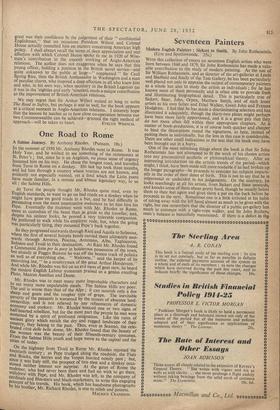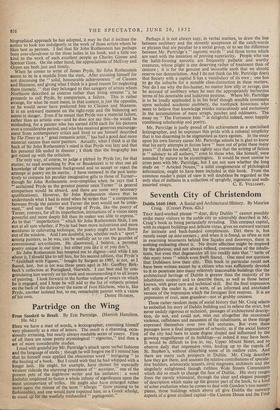Seventeen Painters
Modern English Painters : Sickert to Smith. By John Rothenstein. (Eyre and Spottiswoode. 25s.)
WITH this collection of essays on seventeen English artists who were born between 1860 and 1879, Sir John Rothenstein has made a valu- able contribution to the study of modern painting. As the son of Sir William Rothenstein, and as director of the art-galleries at Leeds and Sheffield and finally of the Tate Gallery, he has been particularly well placed not only to appraise the output of contemporary painters as a whole but also to study the artists as individuals ; for he has known most of them personally and is often able to provide fresh and illuminating biographical detail. This is particularly true of Sickert, Steer, John, Orpen, Matthew Smith, and of such lesser artists as his own father and Ethel Walker, Gwen John and Frances Hodgkins. I feel that he has made a discriminating selection and has illustrated it adequately, though the thirty-two plates might perhaps have been more fairly apportioned, and it is a great pity that they do not more often fall within their appropriate chapters. As a matter of book-production, it is of course both quicker and cheaper to bind the illustrations round the signatures, as here, instead of pasting them in individually, but the loss in this case is considerable. There are other small indications in the text that the book may have been brought out in a hurry.
One of the most refreshing things about the book is that Sir John Rothenstein has not attempted to fit the work of his chosen artists into any preconceived aesthetic or philosophical theory. After an interesting introduction on the artistic trends of the period—which might,1 think, have been made still more readable if he had broken up the longer paragraphs—he proceeds to consider his subjects imparti- ally in the order of their dates of birth. This is not to say that he is impersonal or undecided in his judgements. On the contrary, he looks searchingly at all his artists, from Sickert and Steer onwards, and knocks some of them about pretty hard, though he usually hoists them to their feet again and gives them a pat on the back before he proceeds to the next. Sometimes one is a little irritated at his habit of taking away with the left hand almost as much as he gives with the right, but one remembers that the director of a public art-gallery has much in common with a tight-rope walker, and Sir John Rothen: stein's balance is beautifully maintained. If there is a defect in the
biographical approach he has adopted, it may be that it inclines the author to look too indulgently at the work of those artists whom lie likes best as persons. I feel that Sir John Rothenstein has perhaps been over-chivalrous to the three ladies in his book, and a little too kind to the work of such excellent people as Charles Ginner and Spencer Gore. On the other hand, the appreciations of McEvoy and Orpen are both just and timely.
When he comes to write of James Pryde, Sir John Rothenstein seems to be in a muddle from the start. After excusing himself for not discussing the " solid, honourable achievements " of Clausen and Shannon, and giving what I think is a good reason for neglecting them (namely, " that they belonged to that category of artists whom Northcote described as cisterns rather than living streams "), he proceeds to call Pryde, by comparison, a failure. This is rather strange, for what he must mean, in that context, is just the opposite, or he would never have preferred. him to Clausen and Shannon. It is an awkward moment on the tight-rope and the balancing act seems in danger. Even if he meant that Pryde was a material failure, rather than an artistic one—and he does not say this—he would be misleading, for a painter who has earned £850 each for his pictures over a considerable period, and who has received generous encourage- ment from contemporary critics and lived to see himself described by The Times as a " great romantic artist," has had a good deal more material success than most painters. Actually, what 1 think is at the back of Sir John Rothenstein's mind is that Pryde was lazy and that his personal life ended in disaster ; 1 think that the biography has got mixed up with the criticism. The only way, of course, to judge a picture by Pryde (or, for that matter, to read something by Poe or Baudelaire) is to shut out all knowledge of the personal background and to accept or reject the attempt at poetry on its merits. I have ventured in the past tenta- tively to compare his peculiar imaginative gifts to those of Turner— though Sir John Rothenstein over-simplifies when he says that I " acclaimed Pryde as the greatest painter since Turner " (a general comparison would be absurd, and there are some very necessary qualifications). However, Sir John Rothenstein shows that he understands what 1 had in mind when he writes that " a comparison between Pryde the painter and Turner the poet would not be irrele- vant," and says that " the painting of Pryde, like •the poetry of Turner, conveys, for all its imperfection, intimations of a vision more powerful and more deeply felt than its maker was able to express." As to that " imperfection " which Sir John Rothenstein finds, I am tot at all sure whether, if Pryde had been more industrious and more assiduous in cultivating technique, the poetry might not have flown out of the window. And I am doubtful, too, whether such a " sport " among painters, as he was, can be usefully set to run the gauntlet of conventional art-criticism. He discovered, I believe, a personal poetry unique in our time ; but either you like it or you don't. Sir John Rothenstein has tempted me to digress—and while I am about it, I should like to tell him, for his second edition, that Pryde's 1" Guildhall with Figures," bought by Sargent in 1905, is not, as I feared, lost, but is (or was three years ago) in Mr. Geoffrey Birk- beck's collection at Poringland, Norwich. I can best end by con- gratulating him warmly on his book and recommending it to all lovers of painting. I look forward to the further volume of essays on which he is engaged, and I hope he will add to the list of subjects printed on the back of the dust-cover the name of Ivon Hitchens, who is, like Pryde, another isolated but, to me, remarkable painter with a vision



















































 Previous page
Previous page